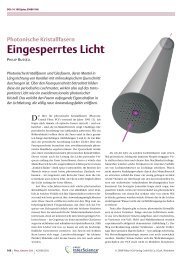Diploma thesis
Diploma thesis
Diploma thesis
Create successful ePaper yourself
Turn your PDF publications into a flip-book with our unique Google optimized e-Paper software.
deadtime may be applied. This deadtime extends the time electrons and holes get<br />
to recombine thus suppressing afterpulsing. The overall single photon detection<br />
efficiency of these detectors can be set up to 25%, by adjusting the base voltage<br />
(parameters in Figure 4.1, efficiency in Figure 4.2).<br />
❏ Trigger Rate (0 - 8 MHz)<br />
❏ Detector Pulse Width (2.5<br />
ns, 5 ns, 20 ns, 50 ns, 100<br />
ns)<br />
❏ Detector Efficiency (10%,<br />
15%, 20%, 25%)<br />
❏ Detector Deadtime (None,<br />
1 µs, 2 µs, 5µs, 10 µs)<br />
Figure 4.1: id201 parameters Figure 4.2: id201 quantum efficiency<br />
Before we used the APDs in an actual PDC experiment, we extensively tested<br />
them. We investigated the dark count level, afterpulsing and additional noise from<br />
remaining pump light guided into the detector.<br />
4.2.1 Dark counts<br />
First, we investigated the effects of stray light and thermal fluctuations. We monitored<br />
the dark counts with a simple setup (see Figure 4.3). We blocked the input<br />
to the detector, a single mode fiber for the near infrared, and applied an external<br />
trigger source. The data acquisition for this experiment has been fully automated<br />
and the trigger generator together with the APDs are remotely controlled (see Appendix<br />
A.2). Our goal was to investigate the effects of trigger rates, pulse width,<br />
detector efficiency and deadtime on the dark count rate. The results are visualised<br />
in Figure 4.4 and 4.5 (for all measurement data, see Appendix 4.5).<br />
As expected, the dark count rate rises linearly with the applied trigger frequency.<br />
The critical parameter for the noise is the gating width. A doubling in gating<br />
time from 2.5 ns to 5 ns (see Figure 4.4 and 4.5) leads to an increased count rate<br />
over one order of magnitude. It is therefore crucial to apply the narrowest gating<br />
possible. The nonlinear increase in the case of 5 ns gatings in Figure 4.5 is a result of<br />
afterpulsing events. As also plotted in Figure 4.5 the afterpulsing can be significantly<br />
reduced by deadtimes longer than 5 µs. For all data, please refer to Appendix A.3.1.<br />
4.2.2 Afterpulsing<br />
To further investigate the effect of afterpulsing, we used two cw-lasers centered<br />
around 1310 nm and 1555 nm. These laser diodes where attenuated with a neutral<br />
42



